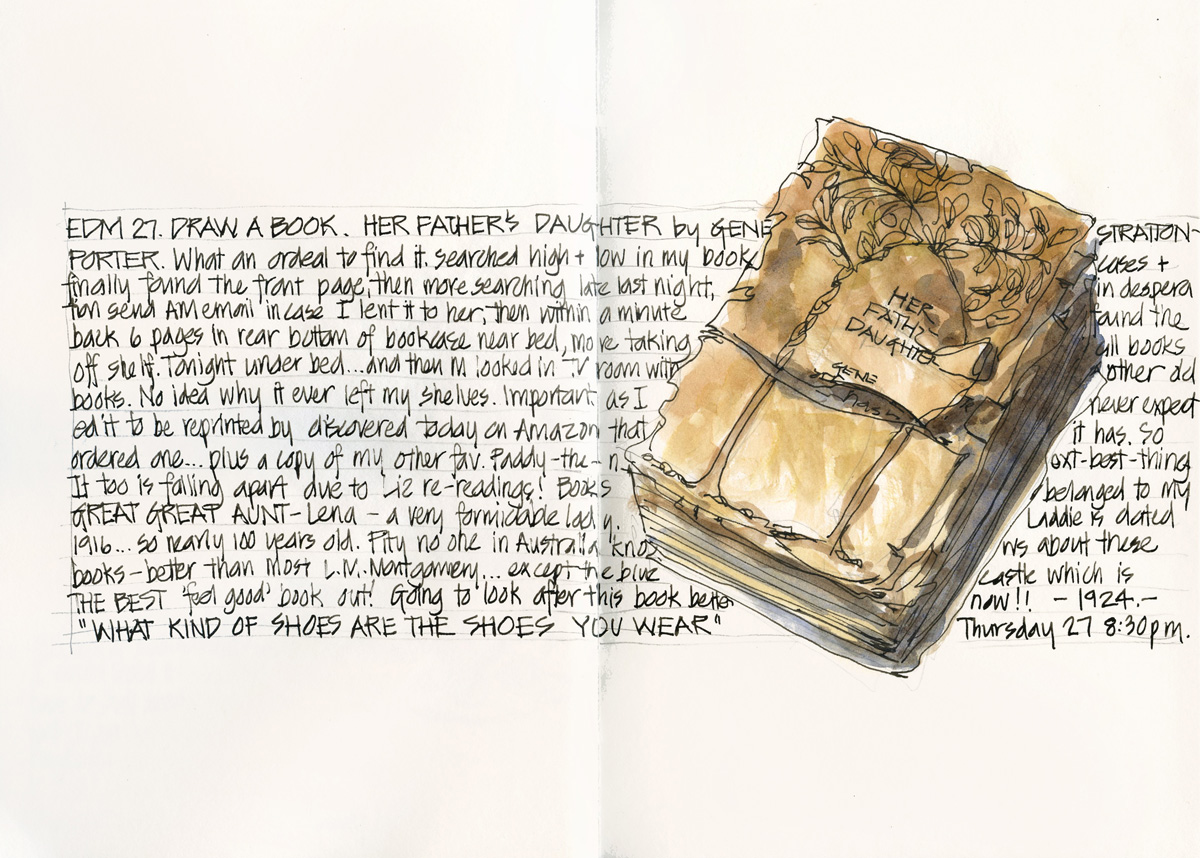
A simple quick sketch…but I have been through so much heartache to get to the point of sketching this… as I could only find the first page and the last six…. but finally tonight after two nights of searching I have been able to reunite all the pages- the cover has long gone!
The book is a 1924 edition of Gene Stratton Porter’s Her Fathers Daughter owned by my Great Great Aunt Lena.
Gene Stratton Porter is practically unknown in Australia in my generation but mum had these old books(all the popular GSP books) that she gave to my sister and me to read when we had read every LM Montgomery book in existence (by the way The Blue Castle is the BEST!!!!!) I much prefer GSP to LMM as a rule.
This book has a MAJOR problem in that it is extremely racist (unbelievably anti-Japanese which might be kinda historically interesting but rather distressing to read in a girls novel) but despite that strand of the plot, I LOVE the rest of the book and it is my favourite GSP book (when I re-read I skip those racist bits)
The heroine Linda is plucky (love that word) and goes on adventures in the canyons collecting desert vegetables and fruit for interesting recipes and sketches and the hero Peter is building a dream home and is so nice. One architect is the villian and the other architect is a female and incredibly talented. Does this sound like a book I would find some interest in? (by the Linda doesn’t drink tea! Well I don’t think so… Maybe I need to re-read it again)
Anyway… This book is precious because I never expected that any one would re-publish it… About 10 years ago, thanks to Amazon, I got copies of all the other GSP books so I could start sharing them with my friends…alas no reprint of this book. Today, I discovered that someone has republished it so guess what has ended up in my cart!
Another WONDERFUL book of Aunty Lena is “Paddy-the –next-best-thing” by Gertrude Page – talk about obscure…but it is great. As I re-read it a lot it is falling to pieces too- so sad!!!
—————–
This is part of the Everyday in May challenge – drawing something every day
in May. A group of us thought it would be fun to do a Everyday Matters (EDM)
challenge each day using EDM 1-31. The list is here
The Group
Me (obviously) flickr or blog
Alissa flickr
Wendy (QuirkyArtist) flickr or blog
Jennifer Blog flickr
Sandy blog or flickr
TravellingSueP blog
Deborah blog
Margaret blog
Anna blog
Marthann blog
Yasemin blog
Carol blog
Anita blog flickr
Matthew flickr
Johanna blog
Sandra blog
Tyanne flickr
PrettyArtyBuildings blog
Maureen flickr
AJoyfulmoc flickr
LuxdLux flickr
Speck blog flickr
Claire blog
Janene blog







2 Comments
This is sure a gorgeous journal page and EDM challenge response, Liz. Even without the cover, this book comes across so beautifully. I recently saw a movie with Glenn Close called "Paradise Road" and it dealt with a shipful of Australian women and children, with a few other nationalities thrown in for good measure, that were both bombed and rescued by the Japanese in WWII. I was wondering if this could be the cause for the anti-Japanese sentiment then I remembered it was published in 1924, so I guess not. I wonder why the sentiment then? Anyway, the rest of the plot sounds super interesting indeed! I've not heard of the author before (not that that means much), despite being an avid reader. So many books, so little time!!!
[Arriving late to the party, I know…] My mother used to raid second-hand book stores to keep up with my voracious reading, which I think is how this book ended up in my home when I was young. I must have been 15 when I read it, because I’d already seen the Sydney Theatre Co. production of Floating World. I found the heroine *so* inspiring and I loved her independent mind and her enterprising and resourceful personality. The fact that she sketched and was a naturalist as well as a kind of freelance journalist – and that there was early C20th architecture in the picture – just added to the appeal. But yes, the deep vein of unquestioned racism was shocking and perplexing to read. Unlike Floating World, where the anti-Japanese sentiment emerges as a result of a character’s trauma in WWII, the racism in GSP’s book seemed so unjustified to me. But apparently racism against the Japanese was especially strong in California, where the book is set, and GSP would have been writing not long after existing prejudice against Asians had been set off anew by the Russo-Japanese war. As I’ve acquired more historical context over time, I’ve been able to understand how GSP might have created a character who was so admirable in so many ways and yet also given her a disturbing racist streak that was never properly questioned or challenged in the book. (All the more perplexing since the heroine is an independent thinker and in so many ways an honourable person. How did she come to “buy into” this racist way of thinking.) But isn’t it weird, the effect of this novel has been so powerful and memorable even though it’s something like 30 years since I read it!
NEWSLETTER
Subscribe for first notification of workshop + online classes and more.